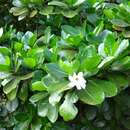en
names in breadcrumbs


Gardenia is a genus of flowering plants in the coffee family, Rubiaceae, native to the tropical and subtropical regions of Africa, Asia, Madagascar and Pacific Islands,[1] and Australia.[2]
The genus was named by Carl Linnaeus and John Ellis after Alexander Garden (1730–1791), a Scottish-born American naturalist.[3]
Gardenias are evergreen shrubs and small trees growing to 1–15 metres (3.3–49.2 ft) tall. The leaves are opposite or in whorls of three or four, 5–50 centimetres (2.0–19.7 in) long and 3–25 centimetres (1.2–9.8 in) broad, dark green and glossy with a leathery texture.
The flowers are solitary or in small clusters, white, or pale yellow, with a tubular-based corolla (botany) with 5–12 lobes (petals) from 5 to 12 centimetres (2.0 to 4.7 in) diameter. Flowering is from about mid-spring to mid-summer, and many species are strongly scented.
Many of the native gardenias of the Pacific Islands and elsewhere in the paleotropics possess a diverse array of natural products. Methoxylated and oxygenated flavonols, flavones, and triterpenes accumulate on the vegetative- and floral-buds as yellow to brown droplets of secreted resin. Many focused phytochemical studies of these bud exudates have been published, including a population-level study of two rare, sympatric species of the Fiji Islands, G. candida and G. grievei.[4] The evolutionary significance of the gums and resins of gardenias in attracting or repelling invertebrate herbivores, has yet to be explored by ecologists.
As of July 2022 Plants of the World Online recognises 128 species in this genus, as follows:[5]
Gardenia plants are prized for the strong sweet scent of their flowers, which can be very large in size in some species.[6]
Gardenia jasminoides (syn. G. grandiflora, G. Florida) is cultivated as a house plant. This species can be difficult to grow because it originated in warm humid tropical areas. It demands high humidity to thrive, and bright (but not direct) light. It flourishes in acidic soils with good drainage and thrives on [20-23 C temperatures (68-74 F)][7] during the day and 15-16 C (60 F) in the evening. Potting soils developed especially for gardenias are available. G. jasminoides grows no larger than 18 inches in height and width when grown indoors. In climates where it can be grown outdoors, it can attain a height of 6 feet. If water touches the flowers, they will turn brown.[8]
In Eastern Asia, Gardenia jasminoides is called zhīzi (栀子) in China, chija (치자) in Korea, and kuchinashi (梔) in Japan. Its fruit is used as a yellow dye,[9] used on fabric and food (including the Korean mung bean jelly called hwangpomuk). Its fruits are also used in traditional Chinese medicine for their clearing, calming, and cooling properties.[10]
In France, gardenias are the flower traditionally worn by men as boutonnière when in evening dress. In The Age of Innocence, Edith Wharton suggests it was customary for upper-class men from New York City to wear a gardenia in their buttonhole during the Gilded Age.[11]
Sigmund Freud remarked to the poet H.D. that gardenias were his favorite flower.[12]
In Tiki culture, "Donn Beach", aka Don the Beachcomber, frequently wore a fresh lei of gardenias almost every day at his Tiki bars, allegedly spending $7,800 for flowers over the course of four years in 1938.[13] He named one of his drinks the Mystery Gardenia cocktail. Trader Vic frequently used the gardenia as a flower garnish in his Tiki drinks, such as in the Scorpion and Outrigger Tiara cocktails.[14]
Several species occur in Hawaii, where gardenias are known as naʻu or nānū.
Crocetin is a chemical compound usually obtained from Crocus sativus, which can also be obtained from the fruit of Gardenia jasminoides.[15] Gordonin is a novel methoxylated flavonol secreted in golden-colored resinous droplets of Gardenia gordonii, which is one of several critically endangered species of the Fiji Islands. Phytochemical studies of these resin droplets have been published, including a population-level study of two other rare, sympatric species on Vanua Levu Island of the Fiji Archipelago, G. candida and G. grievei.[16]
Hattie McDaniel famously wore gardenias in her hair when she accepted an Academy Award, the first for an African American, for Gone with the Wind. Mo'Nique Hicks later wore gardenias in her hair when she won her Oscar as a tribute to McDaniel.
Gardenia is a genus of flowering plants in the coffee family, Rubiaceae, native to the tropical and subtropical regions of Africa, Asia, Madagascar and Pacific Islands, and Australia.
The genus was named by Carl Linnaeus and John Ellis after Alexander Garden (1730–1791), a Scottish-born American naturalist.